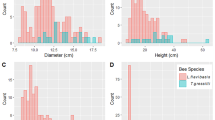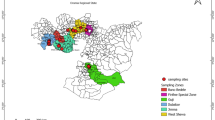Abstract
Tetragonula gressitti Sakagami is the new species of stingless bee discovered in Nagaland (2020). It was earlier found in Arunachal Pradesh (2013), South West China (2019) and Vietnam in 1978. The nest architecture of this particular species was never studied although there had been regular reports of its presence in forest areas by the local populace and all earlier reports were simply documented on the basis of collected samples from forests. This is the first detailed report on nesting characteristics of the stingless bee, T. gressitti, which were found located in the forest and village areas of Phek district in Nagaland during the early winters of 2019. The natural nests were found in tropical to sub-tropical evergreen forests on tree cavities, commonly at a height of 2.91 m ± 0.21 with a single entrance for each colony. The colonies were naturally active as seen and recorded from the activity of bees at their entrance gates during day time. The nests were extracted carefully with appropriate tools and transported to the experimental site. A total of seven natural nests were located for the study. Out of them, three nests were opened to observe the internal nest structure while the remaining nests were kept intact for further development and pollination studies. The observations revealed that the nest entrance on the external region was free from any wax or cerumen funnel/ tube and was meticulously kept clean by the bees. The nest entrances of all the colonies varied in size and shape. Internally, the entrance was connected to the brood through a waxy passage of 11.42 cm ± 0.73 length till it reached the involucrum. The brood was covered in a partial involucrum of 2.15 cm ± 0.23 thickness. The honey pots and pollen pots were found separated from the brood area and were connected through numerous small openings in the involucrum. The adult bees were observed to be deep black in colour. The required data on size of different cells and castes were also recorded accordingly.





Similar content being viewed by others
Data Availability
Photographs and videos are available if required.
References
Barbosa FM, Alves RM, Souza BA, Carvalo CAL (2013) Nest architecture of the stingless bee, Geotrigona subterranea (Fries, 1901) (Hymenoptera: Apidae: Meliponini). Neotropical Biota 13(1):147–152
Batista MA, Ramalho M, Soares AEE (2003) Nesting sites and abundance of Meliponini (Hymenoptera: Apidae) in heterogeneous habitats of the Atlantic rain forest, Bahia, Brazil. Lundiana 4:19–23
Biesmeijer JC, Roberts SPM, Reemer M (2006) Parallel declines in pollinators and insect-pollinated plants in Britain and the Netherlands. Science 313:351–354
Bui M, Singh HK, Alemnila AO, Chauhan A, Behere GT (2020) Diagnistics of wild stingless bees from North East India. Indian Journal of Entomology 82(12):337–342
Campos LAO (1987) Abelhas indigenas sem ferrao: o que sao? Info. Agrop 13 (147)
Chauhan A, Singh HK (2019) Nest architecture studies of stingless bees, Tetragonula iridipennis and Lepidotrigona ventralis in Nagaland. Indian Journal of Entomology 81(1):158–164
Chauhan A, Singh HK (2020) A new record of stingless bee, Tetragonula gressitti sakagami (hymenoptera: apidae: meliponini) from Nagaland. India International Journal of Farm Sciences 10(2):83–87
Eltz T, Bruhl CA, Imiyabir Z, Linsenmair KE (2003) Nesting and nest trees of stingless bees (Apidae: Meliponini) in lowland dipterocarp forests of Sabah, Malaysia, with implications for forest management. For Ecol Manag 172:301–313
Hubbell SP, Johnson LK (1977) Competition and nest spacing in a tropical stingless bee community. Ecology 58:949–963
Jaapar MF, Jajuli R, Mispan R, Ghani, IA (2018) Foraging behaviour of stingless bee Heterotrigona itama (Cockerell, 1918) (Hymenoptera: Apidae: Meliponini). In: AIP Conference proceedings 1940, 020037
Jarau S, Barth FG (2008) Stingless bees of the Golfo Dulce region, Costa Rica (Hymenoptera, Apidae, Apinae, Meliponoini). Stapfia 88:267–276
Kelly N, Farisya MSN, Kumara TK, Marcela P (2014) Species diversity and external nest characteristics of stingless bees in Meliponiculture. Pertanika Journal of Tropical Agricultural Science 37(3):293–298
Michener CD (2013) The Meliponini. In: Vit P, Pedro SRM, Roubik DW (eds) Pot-Honey: A legacy of stingless bees. Springer, New York, pp 3–17
Michener CD (2007) The bees of the world, 2nd edn. Johns Hopkins University Press, Baltimore, p 972p
Nayak PP, Reddy SM, Jayaprakash (2012) Nesting pattern preferences of stingless bee, Trigona iridipennis Smith (Hymenoptera: Apidae) in Jnanabharathi Campus, Karnataka, India. International Research Journal of Biological Sciences 2(2):44–50
Pan P, Wang S, Zhong Y, Xu H, Wang Z (2019) New record of the stingless bee Tetragonula gressitti (Sakagami, 1978) in Southwest China (Hymenoptera: Apidae: Meliponini). J Apic Res https://doi.org/10.1080/00218839.2019.1688494
Rasmussen C (2013) Stingless bees (Hymenoptera: Apidae: Meliponini) of the Indian subcontinent: diversity, taxonomy and current status of knowledge. Zootaxa 3647(3):401–428
Rathor V S, Rasmussen C, Saini MS (2013) New record of the stingless bee Tetragonula gressitti from India (Hymenoptera: Apidae: Meliponini). Journal of Melittology 7:1–5
Roubik DW (2006) Stingless bee nesting biology. Apidologie 37:124–143
Sakagami SF (1978) Tetragonula stingless bees of the continental Asia and Sri Lanka. Journal of the Faculty of Science Hokkaido University series VI Zoology 21(2):165–247
Sakagami SF, Inoue T, Salmah S (1990) Stingless bees of central Sumatra. In: Ohgushi R, Roubik DW (eds) Sakagami SF. Natural History of social wasps and bees in equatorial Sumatra, Hokkaido University Press Sapporo, pp 125–137
Suriwanto N, Atmovidi T, Kahono S (2017) Nesting sites characteristics of stingless bees (Hymenoptera: Apidae) in central Sulawesi. Indonesia Journal of Insect Biodiversity 5(10):1–9
Syafrizal TD, Yusuf R (2014) Biodiversity and habitat of Trigona at secondary tropical rain forest of Lempake education forest, Samarinda. Kalimantan Timur Journal Teknologi Pertanian 9(1):34–38
Acknowledgement
The authors are indebted to Project Coordinator All India Coordinated Research Project on Honey Bees & Pollinators for providing financial support.
Author information
Authors and Affiliations
Corresponding author
Ethics declarations
Consent to participate
We hereby provide the consent to participate.
Consent to publish
We hereby provide the consent to publish our paper in this journal.
Conflict of interest
There is no conflict of interest for publication of manuscript.
Rights and permissions
About this article
Cite this article
Chauhan, A., Singh, H.K. Nest architecture of stingless bee, Tetragonula gressitti Sakagami from Nagaland, India. Int J Trop Insect Sci 41, 3099–3104 (2021). https://doi.org/10.1007/s42690-021-00503-w
Received:
Accepted:
Published:
Issue Date:
DOI: https://doi.org/10.1007/s42690-021-00503-w




